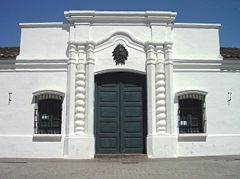
House of Tucumán
Encyclopedia

Argentina
Argentina , officially the Argentine Republic , is the second largest country in South America by land area, after Brazil. It is constituted as a federation of 23 provinces and an autonomous city, Buenos Aires...
, where an assembly of delegates from several provinces of the country (the Congress of Tucumán
Congress of Tucumán
The Congress of Tucumán was the representative assembly, initially meeting in Tucumán, that declared the independence of the United Provinces of South America on July 9, 1816, from the Spanish Empire....
) declared independence from Spain
Spain
Spain , officially the Kingdom of Spain languages]] under the European Charter for Regional or Minority Languages. In each of these, Spain's official name is as follows:;;;;;;), is a country and member state of the European Union located in southwestern Europe on the Iberian Peninsula...
on 9 July 1816.
Distinguishable by its Solomonic columns inf front, the house is an otherwise typical colonial era dwelling in Argentina, and was built near the end of the 17th century for Mayor Diego Bazán y Figueroa. It has three courtyards, one of them surrounded by rooms. Due to its bad condition, it was almost completely demolished in 1903, but it was reconstructed in its original form (based on photographs and documents of the time) in 1941, and it was declared a National Historical Monument the same year.
A son et lumière
Son et lumière (show)
Son et lumière , or a sound and light show, is a form of nighttime entertainment that is usually presented in an outdoor venue of historic significance....
show takes place at the House each evening to set the scene for the story of the declaration of independence. The show ends with the national anthem in front of the Argentine flag, flanked on either side by large reliefs of the historic scenes sculpted by Lola Mora
Lola Mora
Lola Mora was a sculptor, born in a barn in the , though generally considered native to Trancas, province of Tucumán, where she was recorded and baptized. She is known today as a rebel and a pioneer of women in her artistic field...
.

